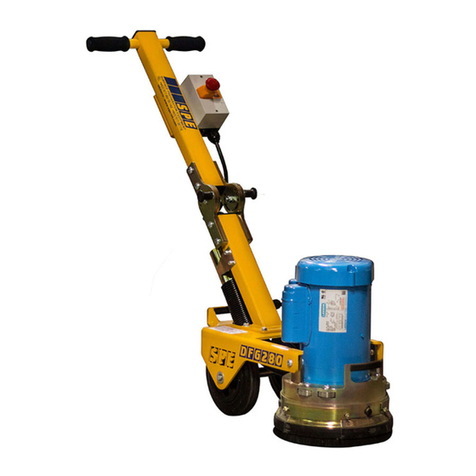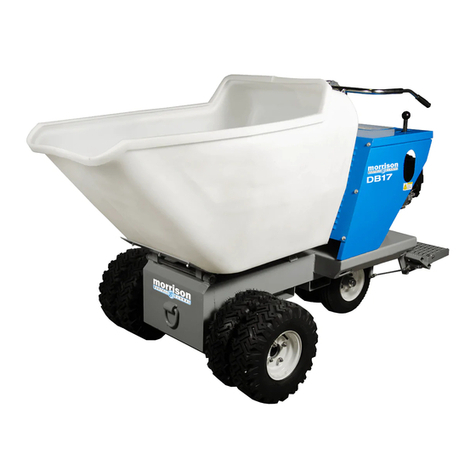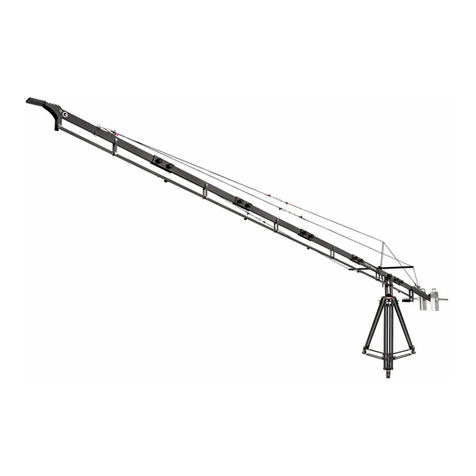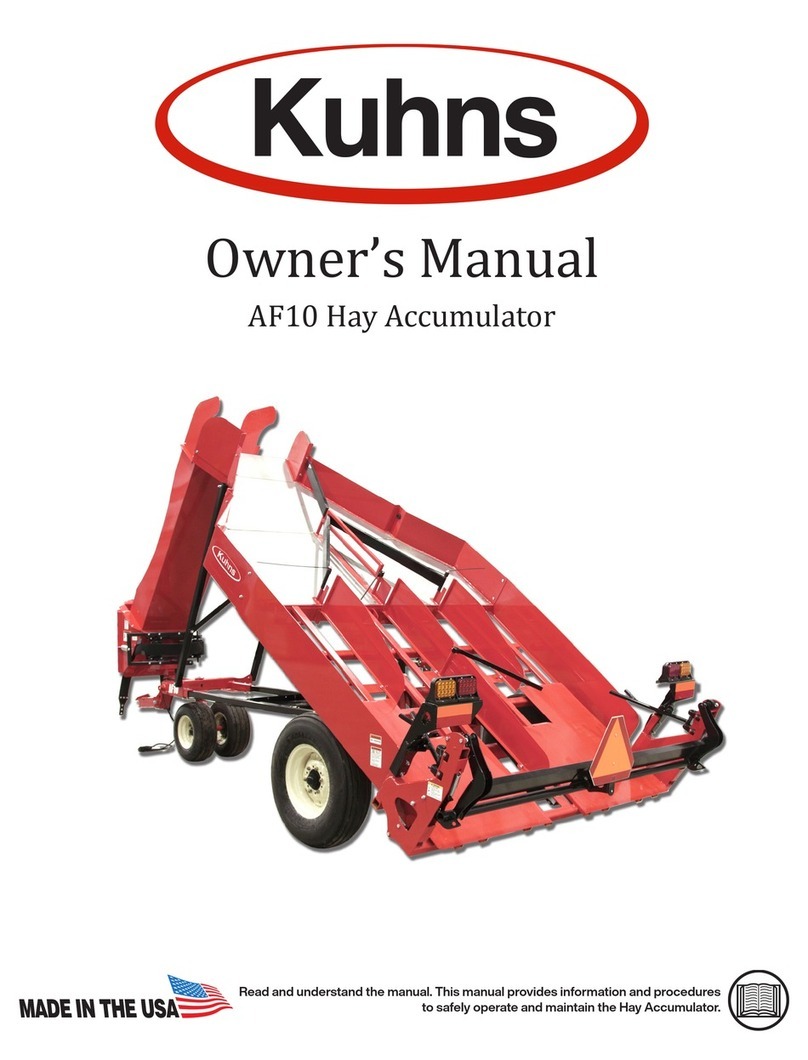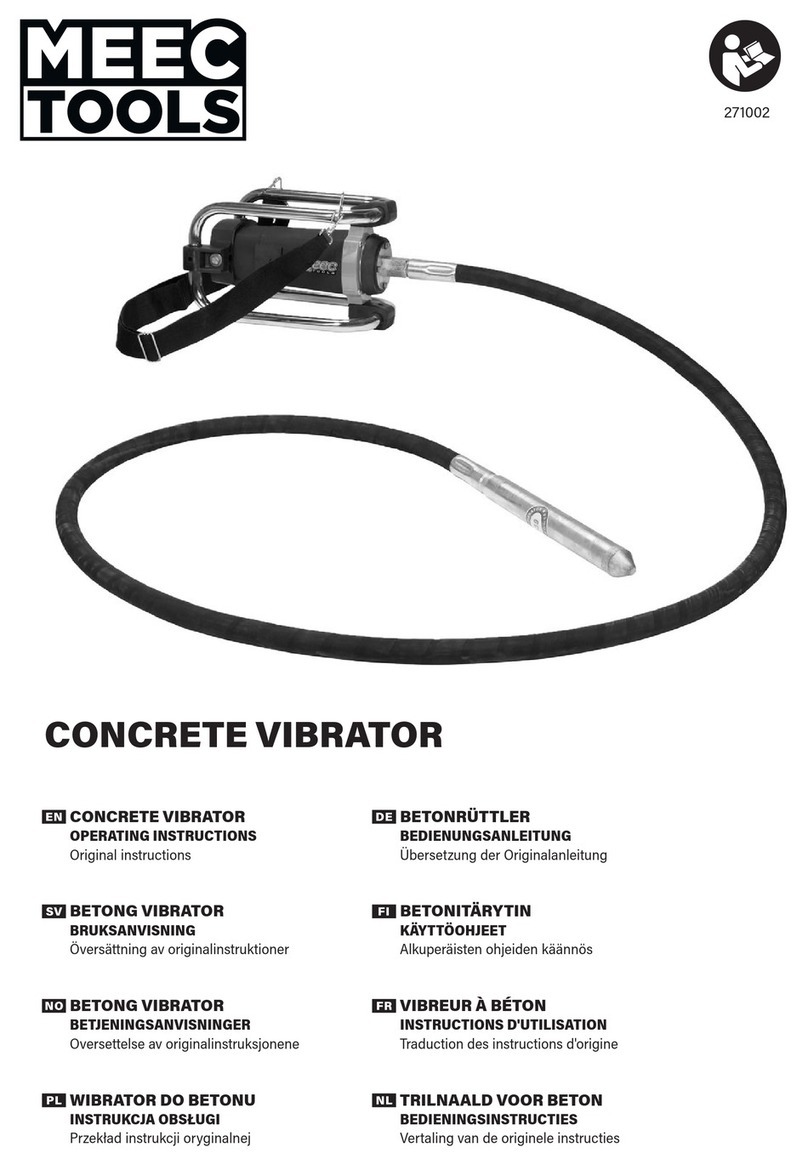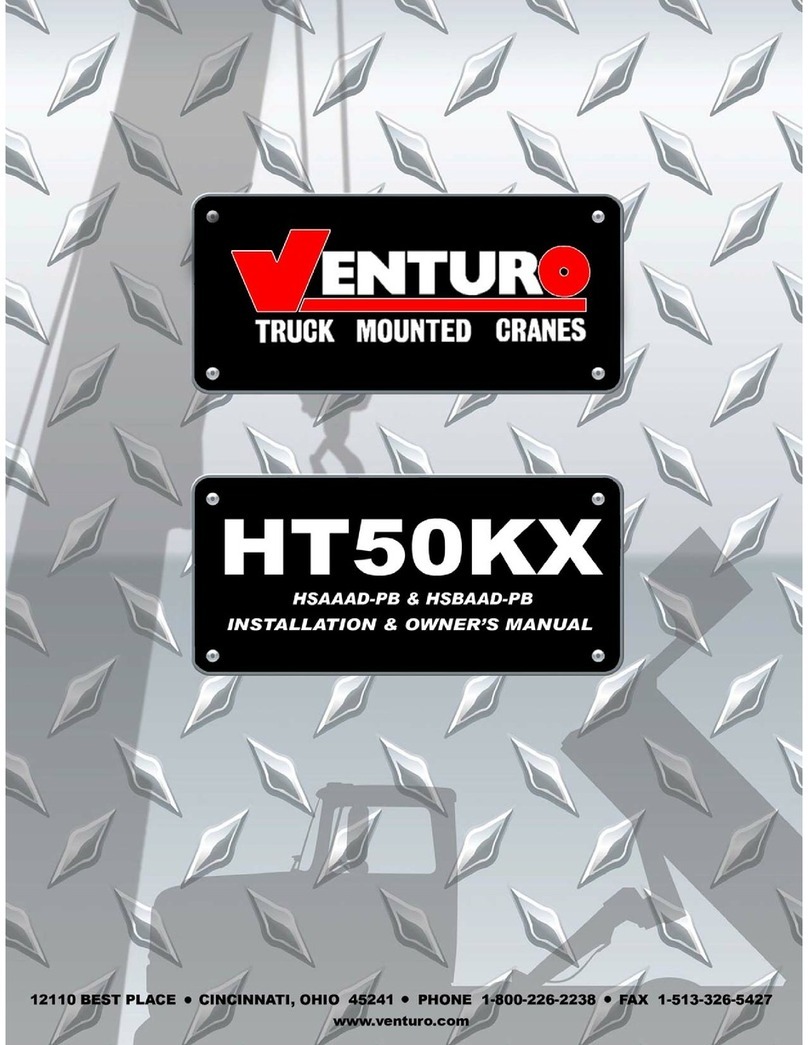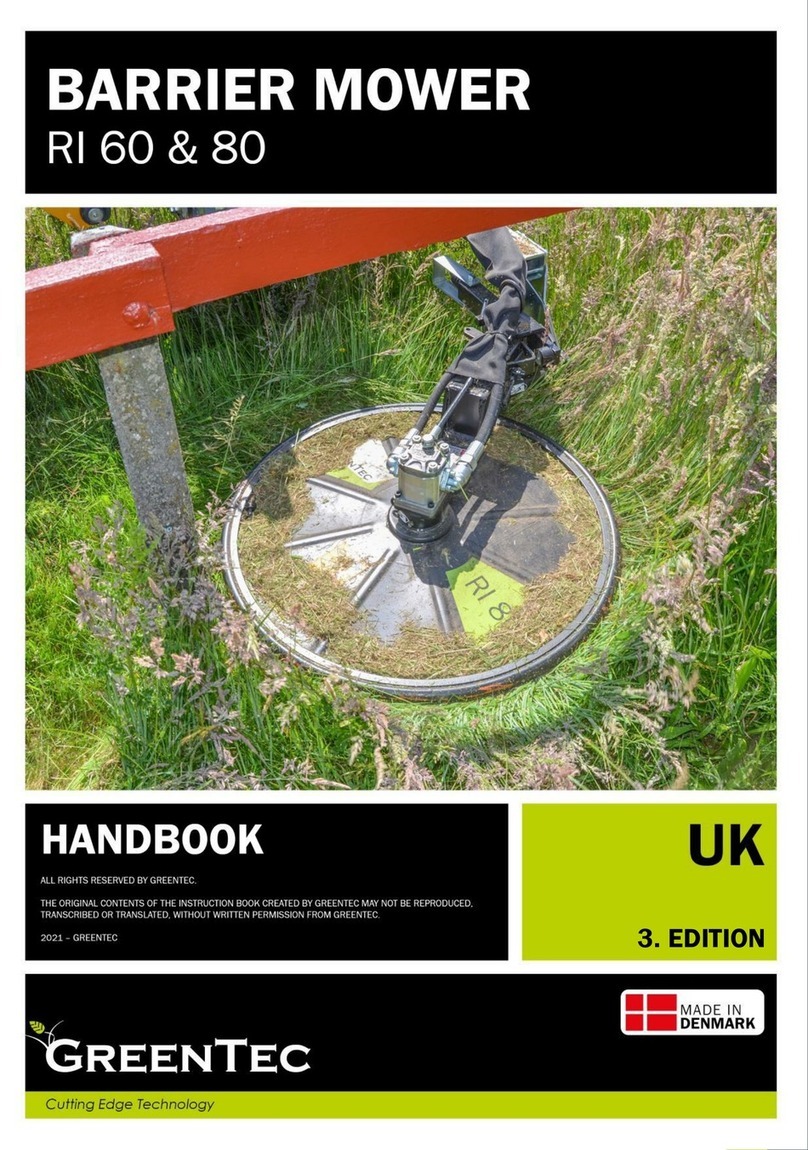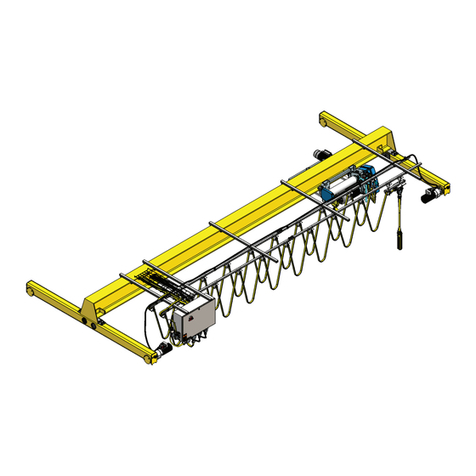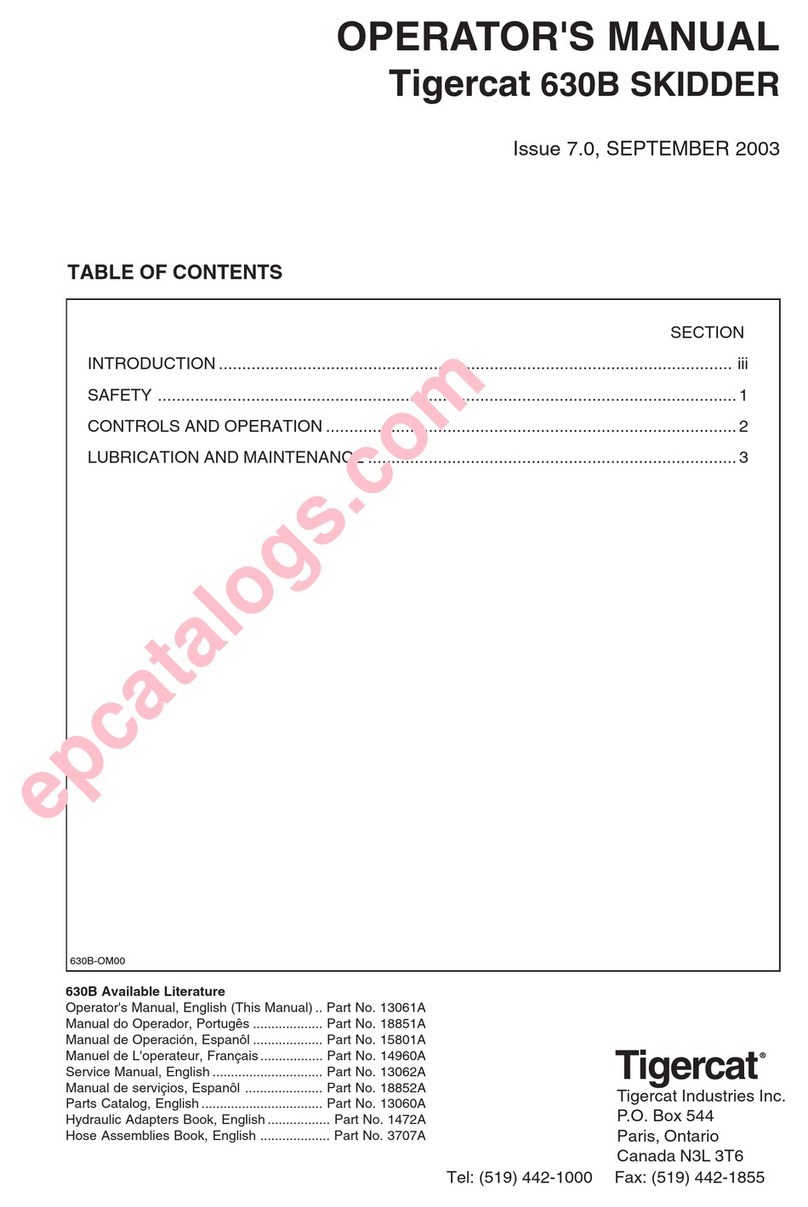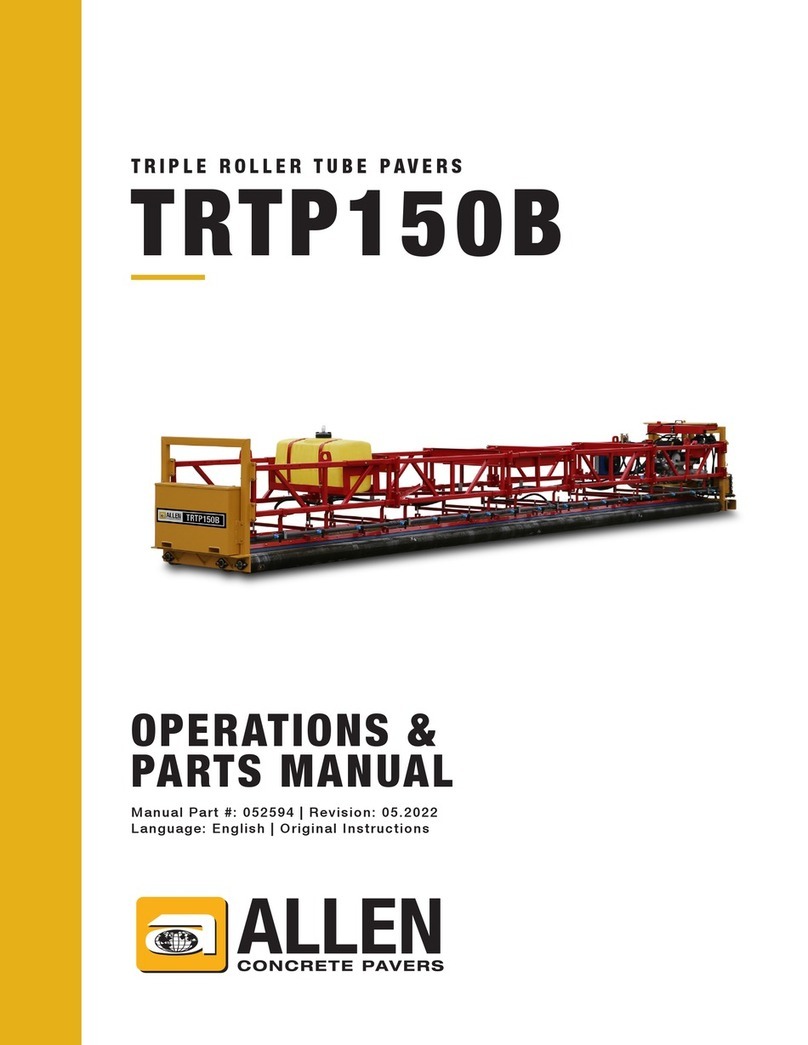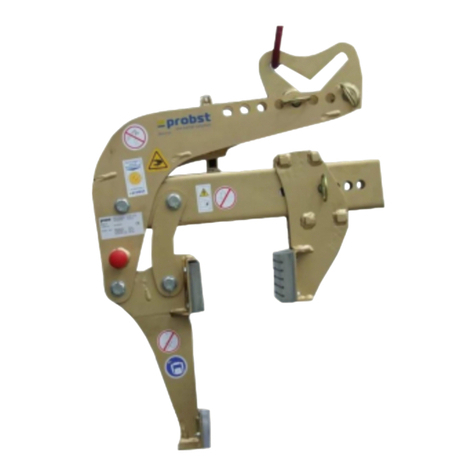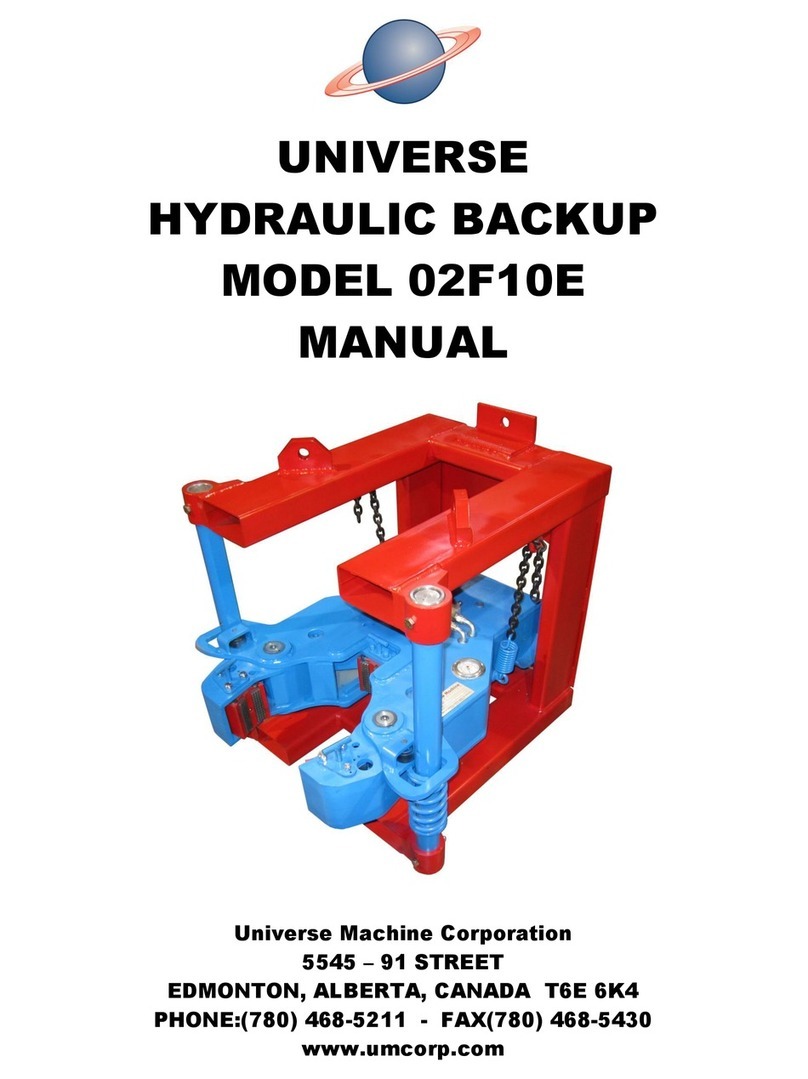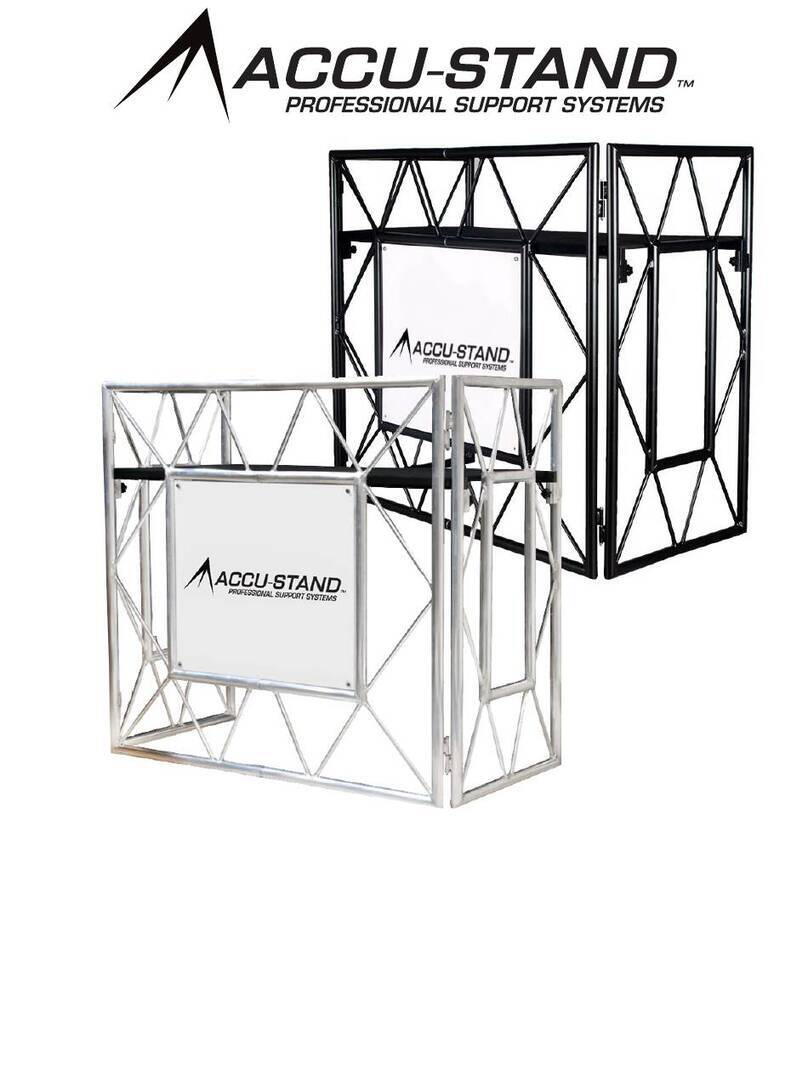Bartell Global CONTEC MODUL 200 User manual

MODUL 200®
Mobile Shotblaster
Instruction manual

Manual MODUL 200®- 2 -
CONTEC Maschinenbau & Entwicklungstechnik GmbH © CONTEC®2016
Hauptstrasse 146, 57518 Alsdorf (Sieg) / Germany
Tel: +49 (0) 2741 9344-0 Fax: +49 (0) 2741 9344-29
INDEX
1. Machine applications ...3
2. Technical data ...3
3. Safety rules ...3
4. Operating and blasting ...4
5. Maintenance and adjustments ...6
5.1 Adjusting the blast track ...6
5.2 Adjusting the height of the blaster ...7
5.3 Wear & tear on the blast wheel and shot cage ...7
5.4 Wear & tear on the linings ...8
5.5 Wear & tear on the shot stop in the separator ...8
5.6 Belt drive ...8
5.7 Wear & tear on the back skirt ...9
5.8 Wear & tear on the magnetic frame and the blast opening ...9
5.9 Bearings ...9
6. Troubleshooting ...10
7. The modular system ...11
7.1 Connecting MODUL 200®EU to MODUL 200®...11
7.2 Additional and interchangeable parts for the extension of MODUL 200®...11
8. Wear & tear parts ...12
9. Shot ...12
10. Appendix ...12

Manual MODUL 200®- 3 -
CONTEC Maschinenbau & Entwicklungstechnik GmbH © CONTEC®2016
Hauptstrasse 146, 57518 Alsdorf (Sieg) / Germany
Tel: +49 (0) 2741 9344-0 Fax: +49 (0) 2741 9344-29
1 Machine applications
Shotblasting of horizontal, dry floors such as concrete and steel surfaces with or without a
coating and asphalt using CONTEC®blasting tools. The use of the machine outside is only
possible in dry weather.
2 Technical data.
MODUL 200®
Working width (mm)
200 (8 in)
Turbine power (kW)
9 kW, 12 hp
Weight (kg)
210 (462 Lbs)
Power requirements
230 V, 3 phases, 32 A
Dimensions (LxHxB) (cm)
Dimensions (HxLxW) (in)
152 x 122 x 34
(48 x 60 x 13)
Average value of acceleration ahv *
2.2 m/s2
Noise level Lwa *
96 dB(A)
Noise level Leq *
85 dB(A)
MODUL 200®+ MODUL 200®EU
Working breadth (mm)
415 (17 in)
Turbine power (kW)
2 x 9 kW, 2 x 12 hp
Weight (kg)
325 (715 Lbs)
Power requirements
230 V, 3 phases, 63 A, 60 Hz
Dimensions (LxHxB) (cm)
Dimensions (HxLxW) (in)
152 x 122 x 54
(48 x 60 x 22)
Average value of acceleration ahv *
2.2 m/s2
Noise level Lwa *
96 dB(A)
Noise level Leq *
85 dB(A)
3 Safety rules for operating the MODUL 200®shotblast machine
The MODUL 200®mobile shotblast machine is constructed according to existing safety
rules and regulations. These technical precautions should not be removed or changed under
any circumstances. While operating the machine the following items should also be kept in
mind:
Disconnect the machine before commencing any servicing or maintenance work –however
menial. Never unplug the machine while it is still running.
This notice can be found in every manual but in nearly every part of the MODUL 200®high
electrical currents are transmitted. The danger of injury is therefore not only from electric
shock, but also from moving parts of the machine.
It is necessary to use safety goggles with side protectors and ear plugs. All persons, in the
operating area of the shotblaster must take these precautions. When switching on, or lifting
the machine during blasting, it is possible that shot escapes at high speed. Unprotected eyes
can be seriously damaged in this case.

Manual MODUL 200®- 4 -
CONTEC Maschinenbau & Entwicklungstechnik GmbH © CONTEC®2016
Hauptstrasse 146, 57518 Alsdorf (Sieg) / Germany
Tel: +49 (0) 2741 9344-0 Fax: +49 (0) 2741 9344-29
Never wear loose or badly fitting clothing. Flapping sleeves may be pulled into the machine
causing serious injury.
All rotating parts of the machine are suitably protected by covers, which prevent clothes or
similar from entering the machine. Under no circumstances should these covers be removed
before you switch the machine on.
Access by unauthorised persons into the blasting area should be prevented. (Due to a high
risk of slipping on lost shot)
The MODUL 200®should be switched off immediately if unusual noises or vibrations are
detected during the operating of the machinery. A thorough check must be carried out in
order to detect the cause.
Always pre check the floor for undulation, stones, screws, or other foreign bodies. It might
be necessary to brush, or in extreme cases, vacuum the floor. Wet or oily spots can make
blasting impossible and damage the dust collector.
Check the power cables regularly as damage may have occurred while operating the
machine. Always disconnect the cables before examination and treat all electrical parts with
extreme care.
4 Operating and blasting
Operating the MODUL 200®must be carried out according to the safety rules in chapter 6.
Transport the MODUL 200®and the dust collector to the floor which is to be blasted. Lifting
the machine will make transportation somewhat easier. In between the rear wheels on the
axel is a pin. By slotting the lifting bar (Appendix diagram No. 185) over this pin the
machine can be lifted. If the machine is lifted, make sure that it can’t slip down from its
raised position. Align the hole in the end of the right rear wheel swing arm (Appendix
diagram No. 193) and the hole in the machine side frame. Now push the clutch pin
(Appendix diagram No. 209) through both holes.
Check and make sure that all wear & tear parts (defined in chapter 11) are in good condition.
If there are any doubts, replace them immediately. Check the power cables.
Connect MODUL 200®with the hose to the dust collector. It is important, that there are no
lesions or holes in the length of hose. Even small holes or a bad connection can significantly
decrease the performance of the dust collector. If small rooms are to be blasted, it is sensible
to use the hose support arch (Appendix diagram No. 169). Connect the hose to the end of the
arch. The arch will then hold the hose away from the rear wheels when reversing.
Connect the power cables of MODUL 200®and the dust collector to the sockets. Insulation
tape or similar can be used to secure the power cable to the hose. The blaster needs a 32 A, 3

Manual MODUL 200®- 5 -
CONTEC Maschinenbau & Entwicklungstechnik GmbH © CONTEC®2016
Hauptstrasse 146, 57518 Alsdorf (Sieg) / Germany
Tel: +49 (0) 2741 9344-0 Fax: +49 (0) 2741 9344-29
phases, 230 V, 60 Hz connection. When operating a double unit (MODUL 200®+ MODUL
200®EU) a 63 A, 3 phases, 60 Hz connection is required.
Check the floor for screws, nuts, or stones etc., and sweep the floor if necessary, with a brush
or vacuum system. Small obstacles like joints pose no problems for MODUL 200®. If there
are bigger undulations or similar check if it is possible for the machine to drive over them
before the turbine is switched on.
ATTENTION !
In the case of severe undulations or difficult joints on the floor it is possible for the magnetic
frame of the machine to rise too far above the floor. The sealing of the shotblaster becomes
ineffective and shot escapes from the machine at high speed. This can cause injury to
persons and equipment. Before operating always check the condition of the floor to prevent
this from occurring.
Lift the control panel and remove the shot compartment lid (Appendix diagram No. 159 -
161). Make sure that the shot valve lever (Appendix diagram No. 165) is on “close” position
and fill the shot compartment with shot until level with the sieve. Do not fill above the sieve
level as suction from the dust collector will suck it away with the dust.
ATTENTION!
Only place new or clean shot in the shot compartment.
Clean the sieve (Appendix diagram No. 157) in the shot compartment if it is blocked.
Take the clutch pin (Appendix diagram No. 209) out of the drill in the rear side of the
machine and put it into the holes of the drive axle (Appendix diagram No. 213). Take the
lifting bar and put the machine in the lower position.
Check the distance of the magnetic frame to the floor. The basic rule is the closer to the
floor the better. Unfortunately, floors are never ideal and mostly uneven. The distance must
be adapted to the floor but should never be more than 10 mm.
Switch the dust collector on.
Pull out the emergency STOP button (Appendix diagram No. 241) and press the START
button (Appendix diagram No. 35). on the control panel. If the indicator light of the button
does not stay on when you release your finger, then the motor wants to start in the wrong
direction. In this case two phases of the power supply must be swapped with each other.
Press the lever (Appendix diagram No. 237) of the drive unit switch and check the direction
and the speed. With the direction forward / reverse switch (Appendix diagram No. 33) it is
possible to change the direction. Only blast in the direction in which the operator has to walk
backwards. The speed is regulated by the speed regulator (Appendix diagram No. 27) on the
lower right end of the control panel. Drive the machine to the place where blasting should
begin.
Now switch the star delta switch (Appendix diagram No. 31) of the turbine motor from 0 to
star (Y) position. Make sure, that the blast wheel is rotating in the correct direction. The right

Manual MODUL 200®- 6 -
CONTEC Maschinenbau & Entwicklungstechnik GmbH © CONTEC®2016
Hauptstrasse 146, 57518 Alsdorf (Sieg) / Germany
Tel: +49 (0) 2741 9344-0 Fax: +49 (0) 2741 9344-29
direction is indicated by a red arrow on the belt drive cover (Appendix diagram No. 187). In
case of wrong rotation, switch the shotblaster off and disconnect the main cable. The plug of
the machine is a phase reverse plug. Turn the two pins in the plug of the machine cable with
a screwdriver. Switch the star delta switch again from 0 to star position. When the required
RPM is reached it then is safe to switch to the delta position whereby the motor runs at full
performance.
Press the lever (Appendix diagram No. 237) of the drive unit switch. MODUL 200®will
start to move with a time delay. Open the shot valve slowly with the shot valve lever
(Appendix diagram No. 165). Do not attempt to open it before the machine is moving or
deep holes will be blasted into the floor.
The Ammeter on the control panel indicates the power consumption of the turbine motor.
Make sure that the consumption is not higher than 15 A (22A US version).
After a few meters of blasting close the shot valve and stop the machine. Check the track on
the floor. If the track is not evenly blasted, adjust the position of the shot cage as described in
the “Maintenance & Adjustment” Chapter.
Repeat the blasting. When the machine is stopped it must be allowed to come to a complete
standstill before switching on the reverse drive direction switch.
ATTENTION!
Abrupt reversing of the drive direction switch causes damage to the drive motor drive circuit.
First stop the machine then reverse the switch!
The dust container of the dust collector has to be emptied on a regular basis. The intervals
depend on the size of the container and on the condition of the floor.
5 Maintenance & Adjustment
ATTENTION ! Disconnect the main cable before starting any maintenance or adjusting.
5.1 Adjust the blasting path
The blasting path is adjusted by turning the shot cage (Appendix diagram No. 119) in the
blast wheel cover (Appendix diagram No. 117). If blasting leaves an uneven path, then one
side of the path is being blasted more heavily than the other.
Remove the shot hose (Appendix diagram No. 125) between the shot valve and the shot
enter pipe (Appendix diagram No. 123). The shot enter pipe is secured with two clamps
(Appendix diagram No. 121) on the blast wheel cover which can be removed by unscrewing
two nuts. The shot cage is situated under and held in position by the shot enter pipe. On
removing the shot enter pipe the shot cage turns freely. Above the centre of the cage window
is a marking point (pin) which is helpful for orientation.
If the path is heavier blasted on the left hand side compared to the right, turn the cage anti –

Manual MODUL 200®- 7 -
CONTEC Maschinenbau & Entwicklungstechnik GmbH © CONTEC®2016
Hauptstrasse 146, 57518 Alsdorf (Sieg) / Germany
Tel: +49 (0) 2741 9344-0 Fax: +49 (0) 2741 9344-29
clockwise. Turn in a clockwise direction if the path is heavier on the right-hand side.
Reconnect the shot enter pipe with the clamps, connect the shot hose and try a short test run.
Repeat the adjustment if necessary, until the path is smooth, even and without variation.
5.2 Adjusting the height of the MODUL 200®
There are three adjustable screws for changing the height of the MODUL 200®. By changing
the height, the gap between the floor and the magnetic frame is adjusted accordingly. For a
more effective performance, the smaller the gap between floor and machine, the better. (Less
wear & tear and loss of abrasive). However, a rough, uneven floor requires a slightly larger
gap than a smooth floor.
For changing the height of the front of the machine, the screw for adjusting is situated on the
upper end of the drive unit frame (Appendix diagram No. 227) under the control panel. For
the back of the machine, the two screws are situated on the rear wheel unit.
Unscrew the nuts of the screws –this applies to all screws. Turning the screws clockwise
lifts the machine, turning them anti clockwise lowers it. The gap between the magnetic frame
(Appendix diagram No. 207, 79 and 81) and the floor should be the same all over. For most
floors, this figure is between 5 mm and 10 mm.
On the front and sides of the magnetic frame are rubber strips (Appendix diagram No. 83)
which act as protective seals against escaping abrasive. If the height of the machine is
changed, the height of the rubber strips must also change accordingly. Slacken screws of the
brackets (Appendix diagram No. 85 and 86) which clamp the rubber strips and place them in
the desired position. They should always lie snug to the floor.
5.3 Wear & tear on the blast wheel and shot cage
The blast wheel (Appendix diagram No. 115) is a pure wear & tear part and must be checked
regularly. CONTEC®recommend a first check after 30 hours of blasting. The life of the
blast wheel depends on the application of the machine.
For example, a lot of wear & tear occurs when blasting soft concrete with a lot of surface fat.
Concrete dust is a very aggressive substance and increases wear & tear enormously. This
decreases when blasting steel or ceramic tiles. To give an accurate figure for the lifetime of
the wheel is therefore impossible. As a rough guide, this could be anywhere between 30 and
100 hours.
Take off the shot hose (Appendix diagram No. 125) in between the shot valve and the shot
enter pipe (Appendix diagram No. 123). Loosen the four nuts which secure the blast wheel
cover (Appendix diagram No. 117) to the machine. Remove the blast wheel cover carefully.
Between the blast wheel cover and the blast chamber is a rubber sealing which may, during
the process of operation stick to both sides. Pay special attention not to tear or rip it. Failure
to do so will result in damage to this sealing.
Now the blast wheel should be visible. In the middle of the blast wheel there is a hexagonal
shaped screw. Loosen the screw and remove the wheel from the blast chamber. Check the
wear & tear on the wheel. The thickness of the four blades should not be less than 5 mm. If
less, the blade could break and destroy the whole wheel.

Manual MODUL 200®- 8 -
CONTEC Maschinenbau & Entwicklungstechnik GmbH © CONTEC®2016
Hauptstrasse 146, 57518 Alsdorf (Sieg) / Germany
Tel: +49 (0) 2741 9344-0 Fax: +49 (0) 2741 9344-29
The shot cage (Appendix diagram No. 119) is like the blast wheel –a pure wear & tear part
and must be checked regularly. Two different kinds of wear & tear on the cage are possible.
The window in the cage has a width of 30 mm. Change the cage if this width is more than 33
mm. The second type of wear & tear is the decrease in the thickness of the cage wall itself.
Change the cage before a hole appears. If the blast wheel and cage are in a good condition
replace the parts using the opposite direction to that described above.
5.4 Wear & tear on the linings
The blast chamber and a large part of the reclaim chamber are protected by linings. These
prevent the machine from destroying itself. The linings must be changed if the thickness is
less than one third of the original thickness in any one place. The most wear & tear happens
to the side (Appendix diagram No. 1) and top linings (Appendix diagram No. 3) of the blast
chamber. The thickness of these linings is 10 mm. Should the wear & tear be more than 6
mm they must be changed. If they are changed too late, the machine will blast a hole in its
frame in a short time.
Changing the linings:
On both sides of the MODUL 200®are the side covers (Appendix diagram No. 71 and 73)
for the reclaim chamber and blast chamber. Remove the side covers by loosening the screws.
The side linings can now be easily removed. On the upper end of the blast chamber are two
screws directly under the turbine motor. Loosen the nuts of these screws and turn them out
by 8 mm. The top lining can now be removed. If this proves difficult, tap gently, but firmly
on both sides with a hammer. The motion of the hammer will remove trapped dust and shot
which may hinder removal of the linings.
The front and back linings of the blast and reclaim chambers are each secured by four (vive)
nuts on the outside of the chambers. Remove the blast wheel (Refer to “wear & tear on the
blast wheel and shot cage”). Loosen the four (vive) nuts and remove the linings. The
installation of the new linings is the reverse procedure to removing them. The lifetime of the
linings should normally be 200 hours. Again, a precise figure cannot be given for the same
reasons described for the blast wheel –i.e. depending on the application.
5.5 Wear & tear on the shot stop in the separator
On the inner side of the shot compartment lid in the separator is the shot stop (Appendix
diagram No. 161). This takes away the energy of the high-speed rebounding shot, thus
preventing the destruction of the shot compartment. It also prevents the dust collector from
sucking shot out of the machine. The shot stop should be regularly checked. Changing the
shot stop is easily done by removing the two screws on the shot compartment lid.
5.6 Belt drive
The belt drive is made to last at least 500 hours –but only if it is tensioned correctly. To
check the tension, remove the belt drive safety cover (Appendix diagram No. 187). It
shouldn’t be possible to move the belt (Appendix diagram No. 97) more than half a cm in
each direction halfway between the pulleys. If it is too loose, adjust the tension by loosening
the four screws which hold the turbine motor (Appendix diagram No. 91). On the upper side

Manual MODUL 200®- 9 -
CONTEC Maschinenbau & Entwicklungstechnik GmbH © CONTEC®2016
Hauptstrasse 146, 57518 Alsdorf (Sieg) / Germany
Tel: +49 (0) 2741 9344-0 Fax: +49 (0) 2741 9344-29
of the motor flange (Appendix diagram No. 181) is a nut. Turn this in a clockwise direction
until the tension of the belt is correct. Tighten the four screws of the motor and tighten the
nut.
ATTENTION!
Secure the belt drive safety cover!
5.7 Wear & tear on the back skirt
The back skirt (Appendix diagram No. 199 to 205) on the rear of the blast opening serves to
prevent shot from escaping and thereby minimises the loss of shot. If the skirt is worn out it
must be replaced. Remove the screws of the bracket which secures the skirt. Remove the
worn-out parts, exchange them and replace the skirt to it’s former position.
5.8 Wear & tear on the magnetic frame and the blast opening
Around the magnetic frame are several parts which must be regularly checked. The parts are
subject to wear & tear through action of the shot and through contact with the floor. In the
front and side areas are the magnetic frames. These are easily removed. The left and right
frames (Appendix diagram No. 79 and 81) are screwed to the side cover. The front frame
(Appendix diagram No. 207) is screwed to a bracket on the reclaim chamber. After removing
the magnetic frame, on the rear side of the opening is another part (Appendix diagram No.
197). The back skirt, mentioned in 8.7, is screwed to this part. Wear & tear happens mainly
to this part if it is in contact with the floor. As previously mentioned, it is important to check
all parts regularly. In doing so, it is not necessary to unscrew the magnetic frame, just place
the machine carefully on its side and check for wear & tear.
5.9 Bearings
Bearings are always tricky in mechanical engineering. To change bearings is generally
simple if the rules are observed. However, for the purpose of this manual, too complex to
describe in any detail. If you have any doubts always refer to trained or experienced
engineer.
The bearings for the MODUL 200®, are situated in the motors, the drive unit lever, the
turbine axle housing, the drive unit frame and the wheels. Never attempt to change the motor
bearings by yourself. Return the motors to CONTEC®or take them to a reputable motor
rewind technician.
The turbine axle housing is the most difficult item to deal with. The bearings inside are
under the greatest stress from the operation of the machine. The lifetime of such high-speed
revolving bearings is between 500 and 1000 hours. To change the bearings, send the
machine or machine housing to CONTEC®.

Manual MODUL 200®- 10 -
CONTEC Maschinenbau & Entwicklungstechnik GmbH © CONTEC®2016
Hauptstrasse 146, 57518 Alsdorf (Sieg) / Germany
Tel: +49 (0) 2741 9344-0 Fax: +49 (0) 2741 9344-29
6 Troubleshooting
If, after activating the machine by pressing “START” the run lamp is lit but all or part of the
motor is not running –check the following:
- Is the power connection correct?
- Are the cables in a good condition and properly laid?
- Are the fuses in the control panel closed?
- Is the motor overload protection in the control panel closed?
The turbine motor is not working.
- Has the blast chamber filled up with shot and blocked the blast wheel during transportation of the machine?
- Is the motor overload protection in the control panel closed?
The drive motor is not working.
- Is the fuse for the drive unit in the control panel closed?
- Are both (glass) fuses on the control circuit OK?
- Does the drive wheel turn easily when not connected to the drive motor?
The blast performance is too low.
- Is the blast wheel turning in the right direction?
- Has the blast wheel worn out?
- Has the shot cage been correctly adjusted?
- Has the shot cage worn out?
- Is the sieve in the shot compartment blocked?
- Is the shot valve blocked?
- Is the shot worn out? (Check the size of the balls)
MODUL 200®works for a short time and loses all the shot (carpeting effect).
- Is the blast wheel rotating in the correct direction?
- Has the blast wheel worn out?
- Has the shot cage been correctly adjusted?
- Has the shot cage been worn out?
- Do the rubber seals of the magnetic frame lie snugly with the floor?
- Have the rubber seals worn out?
- Is the height of the machine positioned too high?
- Is the belt of the turbine too lose? (The belt will slip on the pulleys and the blast wheel will not rotate quickly
enough).
- Is it possible to blast the floor? Check the condition.
- Is it dry and not too elastic or soft?

Manual MODUL 200®- 11 -
CONTEC Maschinenbau & Entwicklungstechnik GmbH © CONTEC®2016
Hauptstrasse 146, 57518 Alsdorf (Sieg) / Germany
Tel: +49 (0) 2741 9344-0 Fax: +49 (0) 2741 9344-29
7 The modular system
7.1 Connecting MODUL 200®EU to MODUL 200®
In the following the connection of a MODUL 200®EU to a MODUL 200®basic unit is described. It is
assumed, that the control panel for a double unit has already been prepared.
Remove the left side cover (Appendix diagram No. 71) of MODUL 200®. Now remove the left side linings of
the blast chamber (Appendix diagram No. 1) and the reclaim chamber (Appendix diagram No. 9). Above the
left side cover is another cover (Appendix diagram No. 153) for the shot compartment, remove this also.
Remove the back skirt (Appendix diagram No. 199 to 205) and the rubber sealing (Appendix diagram No. 83)
of the magnetic frame.
Place the MODUL 200®carefully on its right side. Taking care not to damage the shot valve lever or the
remote-control cable.
Remove the upper rear wheel (Appendix diagram No. 189). Place the level adjustment connector in the now
empty axle of the rear wheel system.
Insert the clutch for the shot valves into the shot valve axle (Ap. diagram No. 133).
Place the separating linings (thickness 15 mm) for the reclaim and blast chamber in the position of the removed
side linings.
Place the MODUL 200®EU carefully on MODUL 200®. Make sure that the level adjustment connector of the
rear wheel is connected to both machines and that the position of the separating linings is correct.
Without the aid of power tools, hand screw both units together and connect the side cover to MODUL 200®
EU. Now connect the rear wheel to MODUL 200®EU. Return the machine to the normal upright position then
screw first the side cover and then both units tight together. Connect the shot compartment side cover to
MODUL 200®EU
Lift the control panel and remove the shot compartment lids (Appendix diagram No. 159 to 163). Align the
valve (Appendix diagram No. 129) of MODUL 200®EU to the same position of the MODUL 200®valve. To
align the valves correctly loosen the screws of the shot valves and place them in the same position. Pull the
clutch on both valve axles and secure them.
Connect the double back skirt to both units. Connect the rubber seals to the magnetic frames.
Loosen the cable protector on the right side of the machine and insert the cable of the MODUL 200®EU
turbine motor inside. Connect the plug of the cable to the socket on the control panel.
7.2 Additional and interchangeable parts for the extension of MODUL 200®
Additional parts:
Clutch for the shot valves
Connection pin for the rear wheel swing
Interchangeable parts:
Back skirt
Rubber sealing for the magnetic frame
Separating linings

Manual MODUL 200®- 12 -
CONTEC Maschinenbau & Entwicklungstechnik GmbH © CONTEC®2016
Hauptstrasse 146, 57518 Alsdorf (Sieg) / Germany
Tel: +49 (0) 2741 9344-0 Fax: +49 (0) 2741 9344-29
8 Wear & tear parts
Definition of wear & tear parts:
Blast wheel, Shot cage, Linings,
Magnetic frame, Bracket for the back skirt, Back skirt,
Rubber sealing for the magnetic frame,
Shot stop, Blast wheel cover,
Shot hose,
Poly-V belt of the turbine,
Poly-V Pulleys of the turbine
9 Shot
Different floors need different shot. Here is a list of shot with the fitting application.
According to
BSS 2451
According to
SAE J444a
Shot size
Application
S390
S390
1,0-1,7 mm
Plain concrete or coatings
S340
S330
0,85-1,4 mm
Plain concrete to achieve a fine profile
G34-G47
0,85-2,0 mm
Concrete with difficult coatings.
Steal surfaces like bridges, ship decks and tanks.
G34-G47 should never be used pure. Always
mix it with S390/340/330. Not more then 1 part
of G34 –G47 on two parts of S390/340/330
10 Appendix
Diagrams
Wire diagram
Part list

Manual MODUL 200®- 13 -
CONTEC Maschinenbau & Entwicklungstechnik GmbH © CONTEC®2016
Hauptstrasse 146, 57518 Alsdorf (Sieg) / Germany
Tel: +49 (0) 2741 9344-0 Fax: +49 (0) 2741 9344-29
PARTS BREAKDOWN

Manual MODUL 200®- 14 -
CONTEC Maschinenbau & Entwicklungstechnik GmbH © CONTEC®2016
Hauptstrasse 146, 57518 Alsdorf (Sieg) / Germany
Tel: +49 (0) 2741 9344-0 Fax: +49 (0) 2741 9344-29

Manual MODUL 200®- 15 -
CONTEC Maschinenbau & Entwicklungstechnik GmbH © CONTEC®2016
Hauptstrasse 146, 57518 Alsdorf (Sieg) / Germany
Tel: +49 (0) 2741 9344-0 Fax: +49 (0) 2741 9344-29
Item #
Part #
Description
QTY
38
8750203308
Contact Element
2
39
8750202309
Mounting Adapter
3
69
8750101000
Complete Control Panel
1
91
8755140075
Motor 7,5 KW
1
151
8710100000
Machine Frame
1
153
8730102700
Shot Compartment Cover left and right
2
154
8730100104
Bar for Control Panel Bracket
2
155
8730100103
Bracket Control Lever
1
157
8730100400
Sieve without Handle
1
159
8790215016
Handle
2
161
8730100504
Shot Stop
1
163
8730100501
Shot Compartment Lit only
1
165
8790200010
Control Lever
1
167
8730100701
Bracket for Shot Valve Cable at Frame
1
169
8730102802
Hose Support Arch
1
171
8730102801
Hose Support Bracket
1
179
8730102300
Bracket for Belt Tensioner
1
181
8730100600
Belt Tensioner
1
183
8770212610
Rubber Grip
2
185
8730100900
Lifting bar
1
187
8730102501
Belt Cover
1
189
8780203160
Rear Wheel
2
191
8730100804
Axis
2
193
8730100800
Swing Rear Axis
1
195
8730100700
Cabel Pipe
1
197
8730102600
Retaining Plate for Back Skirt
1
199
8730101501
Back Skirt half Pipe
1
201
8770233503
Back Skirt Rubber under Bracket
1
203
8730101502
Bracket for Back Skirt
1
205
8770230006
Back Skirt Rubber
1
207
8730101200
Front magnetic Frame
1
209
8790250001
Drive Pin
1
211
8730100205
Drive Unit Axis Cover
1
213
8730170202
Drive Axis
1
215
8761206191
Bearing
2
217
8730170201
Axis for Drive Wheel
1
219
8780203200V
Drive Wheel
1
221
8750202020
Gearbox
1
223
8750202019
Drive Unit Motor
1
225
8730100200
Drive Unit Frame
1
227
8730100204
Lifting Tube
1
229
8730100302
Lower Lifting Arm
1
230
8761206002
Bearing
2
231
8730100303
Top Handle
1
233
8750201001
Drive Unit Switch complete
1
235
8730100304
Drive Unit Lever Alloy
1
239
8750202102N
Housing for Emergency Switch
1
241
8750202301
Emergency Switch
1
243
8770273535
Plastic Plug
1
291
8790201010
Chain for Electic Box
1

Manual MODUL 200®- 16 -
CONTEC Maschinenbau & Entwicklungstechnik GmbH © CONTEC®2016
Hauptstrasse 146, 57518 Alsdorf (Sieg) / Germany
Tel: +49 (0) 2741 9344-0 Fax: +49 (0) 2741 9344-29

Manual MODUL 200®- 17 -
CONTEC Maschinenbau & Entwicklungstechnik GmbH © CONTEC®2016
Hauptstrasse 146, 57518 Alsdorf (Sieg) / Germany
Tel: +49 (0) 2741 9344-0 Fax: +49 (0) 2741 9344-29
Item #
Part #
Description
QTY
1
8720120008
Side Lining Blast Chamber
2
3
8720120005
Top Lining Blast Chamber
1
5
8720120003
Lining Blast Chamber Bearing Housing
1
7
8720120004
Front Lining Blast Chamber Blast Wheel Cover
1
9
8720120007
Side Lining Reclaim Chamber
2
11
8720120002
Lining Reclaim Chamber inside
1
13
8720120001
Front Lining Reclaim Chamber outside
1
15
8720120012
Curved Lining Reclaim Chamber
1

Manual MODUL 200®- 18 -
CONTEC Maschinenbau & Entwicklungstechnik GmbH © CONTEC®2016
Hauptstrasse 146, 57518 Alsdorf (Sieg) / Germany
Tel: +49 (0) 2741 9344-0 Fax: +49 (0) 2741 9344-29

Manual MODUL 200®- 19 -
CONTEC Maschinenbau & Entwicklungstechnik GmbH © CONTEC®2016
Hauptstrasse 146, 57518 Alsdorf (Sieg) / Germany
Tel: +49 (0) 2741 9344-0 Fax: +49 (0) 2741 9344-29
Item #
Part #
Description
QTY
71
8730101100
Side Covering right
1
73
8730101000
Side Covering left
1
75
8770270070
Cap 70 mm
1
77
8770271070
Plug for hole diameter 70 mm
1
79
8730101400
Right magnetic Frame
1
81
8730101300
Left magnetic Frame
1
83
8770238006
Rubber Sealing magnetic Frame
2
85
8730102401
Side Bracket for Rubber
2
86
8730102402
Front Bracket For Rubber
1
91
8755140075
Motor 7,5 KW
1
93
8790240130
Pulley
1
95
8.79024161028
Taper Bush
1
97
8770243208
Poly-V Belt
1
99
8790240044
Pulley
1
101
8731171003
Plate Bearing Housing Belt Drive
1
103
8761206306
Bearing
1
105
8730171004
Turbine Axis
1
107
8761206305
Bearing
1
108
876325 4X24
Pin 4x24 mm
2
109
8730171001
Bearing Housing
1
111
8731171002
Plate Bearing Housing Blast Wheel
1
113
8731171005
Blast Wheel Socket
1
115
8730151900
Blast Wheel
1
116
8770231706
Gasket For Blast Whel Cover 3 mm
1
117
8730101700
Blast Wheel Cover
1
119
8730151702
Shot Cage
1
121
8730101704
Clamp for Shot Enter Pipe
2
123
8730101703
Shot Enter Pipe
1
125
8770257001
Shot Hose
1
127
8730141601
Shot Valve Alu-Pipe With Magnets
1
129
8730101603
Shot Valve Disc
1
131
8730101604
Shot Valve Lever
1
133
8730101602
Shot Valve Axis
1

Manual MODUL 200®- 20 -
CONTEC Maschinenbau & Entwicklungstechnik GmbH © CONTEC®2016
Hauptstrasse 146, 57518 Alsdorf (Sieg) / Germany
Tel: +49 (0) 2741 9344-0 Fax: +49 (0) 2741 9344-29
Table of contents
Other Bartell Global Construction Equipment manuals
